
We are good 47 planned presentations in our Pitch Deck Teardown series, and one piece of feedback we got most frequently is that it’s easy to be critical: we I finish?
Well, we’re not one to shy away from a challenge here at TechCrunch+. So, for this week’s pitch breakout, we’re going to try something different.
About six months ago, we went through an introduction scheme by a company called Supliful. We celebrated the presentation set for being so good, but we might have taken a little fun for being riddled with misspellings and other absurdity. Despite this, the deck was intrinsically good.
So, for this week’s breakout, I chanced upon the team at Trulytell (with the help of their designer, Jake Muller) to refine the Supliful’s surface until it was the perfect court surface.
Well, we didn’t quite get it 100%. There are still some issues, and in this post, we’ll break them down to see what can be improved and how to do it.
We’re looking for more unique planner presentation decks to tear down, so if you want to send one of your own, here’s how to do it.
slides in this group
- cover slide
- traction slide
- Summary slide
- problem slide
- What makes a great CPG Brand Slide?
- solution slide
- product segment
- Case study slide
- business model segment
- market segment
- Predicate business segment
- competitor segment
- testimonial slide
- Team slide
- Ask the slide
- Operating plan slide
- Slide close
The first five slides
We’re going to do things differently this week: I’m going to break down each slide in detail and explain why it works and what works for it. I’ll also explain what could be improved or where investors might ask tough questions.
So we’ll cover the first 5 slices here and stick the remaining 15 behind the firewall. Yes, you should absolutely subscribe to TechCrunch+: Did I Mentionsed That we have nearly 50 sample pitch decks planned, complete with commentary, and upwards of 30 to 40 articles analyzing every imaginable aspect of pitches and speeches?
If you are a founder raising money, this is the biggest benefit you will get. Go on, subscribe. Makes sense.
With that out of the way, let’s do this!
Slide 1: Cover slide
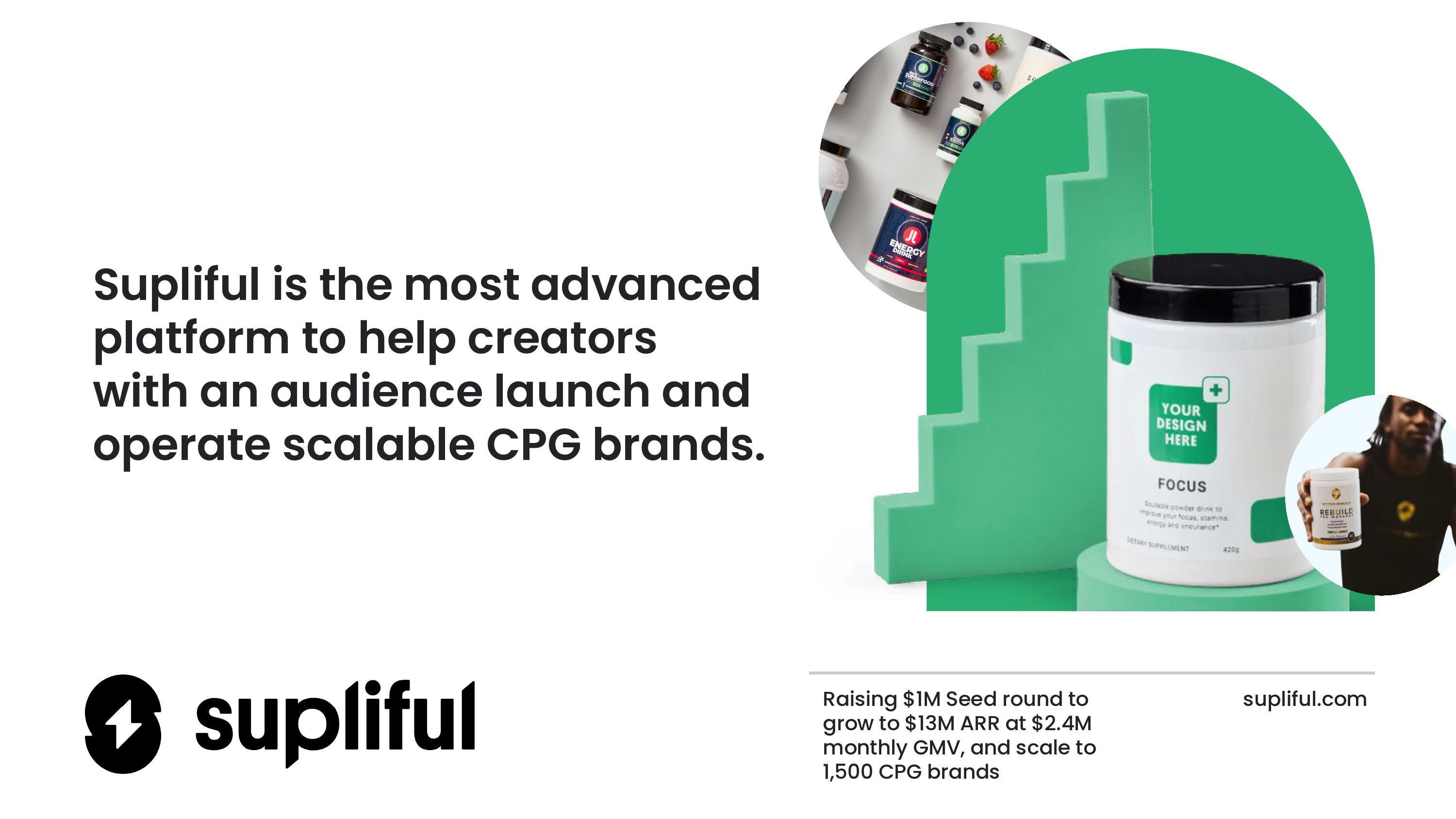
(Slide 1) Well, that’s beautiful land you might say. Let’s go! Image credits: Supliful / TechCrunch / Trulytell
The opening slide does a lot of the heavy lifting to help investors decide if your startup is on the thesis. This part defines a set of essential parts of the business:
- Shows a summary of what the business is about (“the most advanced platform to help creators get their CPG brands up and running”).
- Shows the amount they collect ($1 million).
- It spells out fundraising goals (“Grow to $13 million ARR at $2.4 million per month GMV”).
- The image shows what the company is actually doing: “Your Design Here” along with the influencer.
- Between the lines, you realize this is a B2B2C company, assuming influencers and content creators are businesses.
What works for this chip: It clearly sets the pace for what’s to come. It conveys a lot of information that will enable an investor to quickly say “no” if the size of the round, the industry, or the overall business idea is not attractive to them.
What could be improved: This company is based in Riga, Latvia, located in northeastern Europe. This may “kill it” for many investors who have a site as part of their investment thesis. We decided not to include that on this slide and made sure to use Slide 2 (traction) to show what the company is currently doing. Maybe this is a little disingenuous, but we thought we didn’t want to unduly bias investors – let’s get them excited about the company and its potential!
We also could have determined that this is a B2B2C company, but we figured a savvy investor might figure that out given the information here.
Hopefully, the graphic on this slide tells you an important part of the story, but there may be better ways to illustrate Supliful’s core business model.
Finally, I spent some time considering whether we should clarify what CPG (Consumer Packaged Goods) stands for. But I realized that if an investor needed to google CPG, there was no way to invest in that space, so I left it as the slightly obscure TLA.
Slide 2: Traction slider
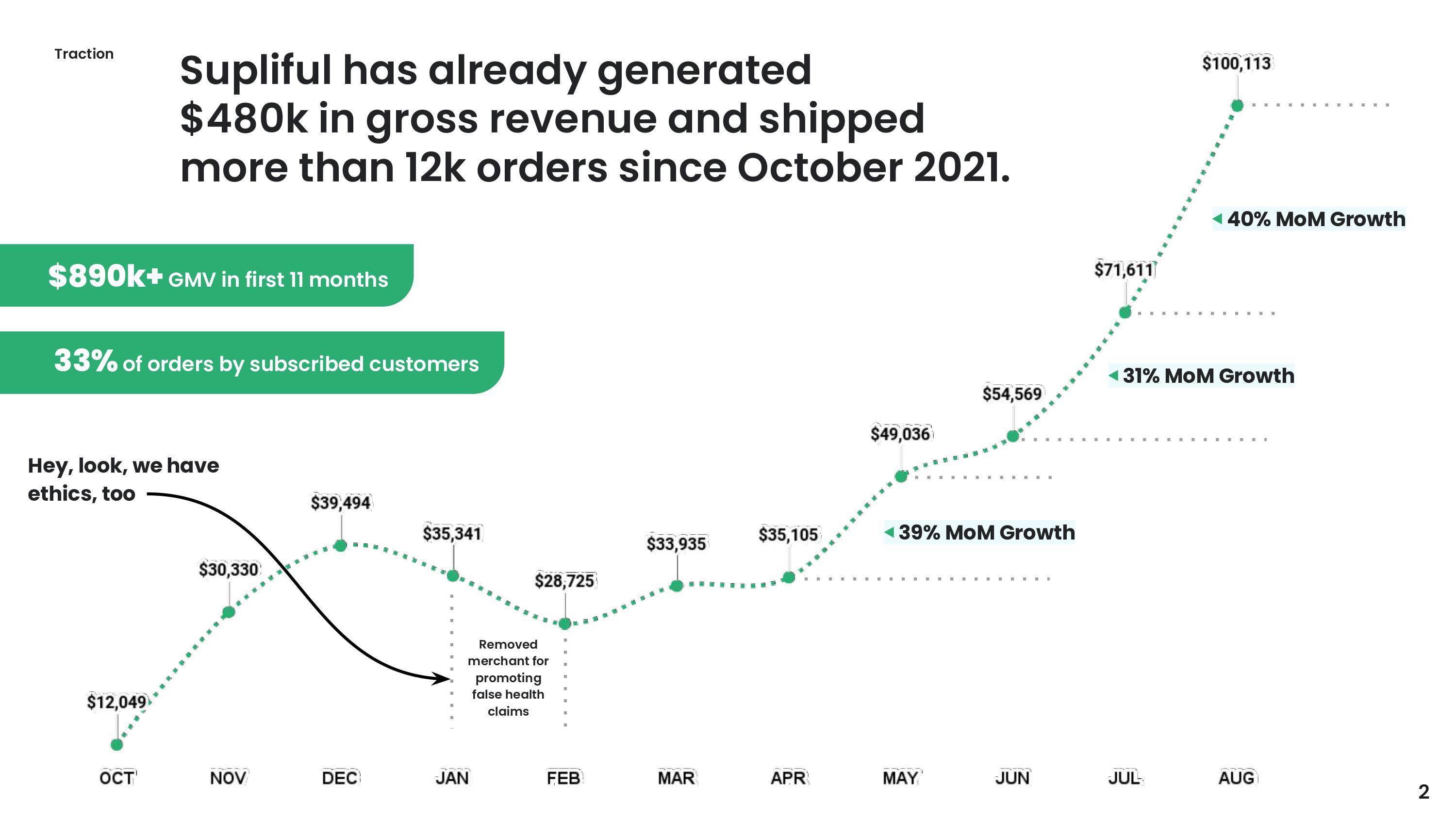
(Slide 2) Up and to the right. Image credits: Supliful / TechCrunch / Trulytell
What do you do when you have a company that has some fundraising challenges but a lot of attractive promise?
My opinion is always this: If you have an income, then you have proven that you can achieve the hardest part of building a startup. It almost doesn’t matter what else is wrong with the business, if you’re making sales, you’re on to something. Once you have traction, the question becomes how much does it cost to acquire new customers, what is the value of those customers and how big is the market.
Opening with a traction slide requires an explanation of what traction represents. This slide looks very simple, but it transmits a a lot From the data: Sharp growth, some cumulative numbers and some nice indicators for a company on a steep growth trajectory.
What works for this chip: There was a decrease in revenue, but it turns out that the company had a good reason for this: it had to kick one of the merchants off the site for being dishonest. A drop in revenue is a bad thing, but highlighting it with the stock and an explanation goes a long way toward alleviating concerns. Revenue was down in the previous month as well, which isn’t something to address, but the graph shows exponential growth in the six months since.
Plus, I like how this graph shows revenue, not gross merchandise value (GMV). It would have been easy to “pump out” the numbers by quoting the GMV here, but the founders (and savvy investors) know the scale makes little sense.
What could be improved: It can be said that some of these scales are vanity scales. Total cumulative revenue is tricky: yes it counts, but the growth curve is so steep that it shows a skewed picture that isn’t actually in the company’s favor.
The “33% of orders are from mutual customers” number could do with some explanation, but you have the opportunity to talk about how mutual customers generate recurring revenue through voiceover.
Slide 3: Summary slide
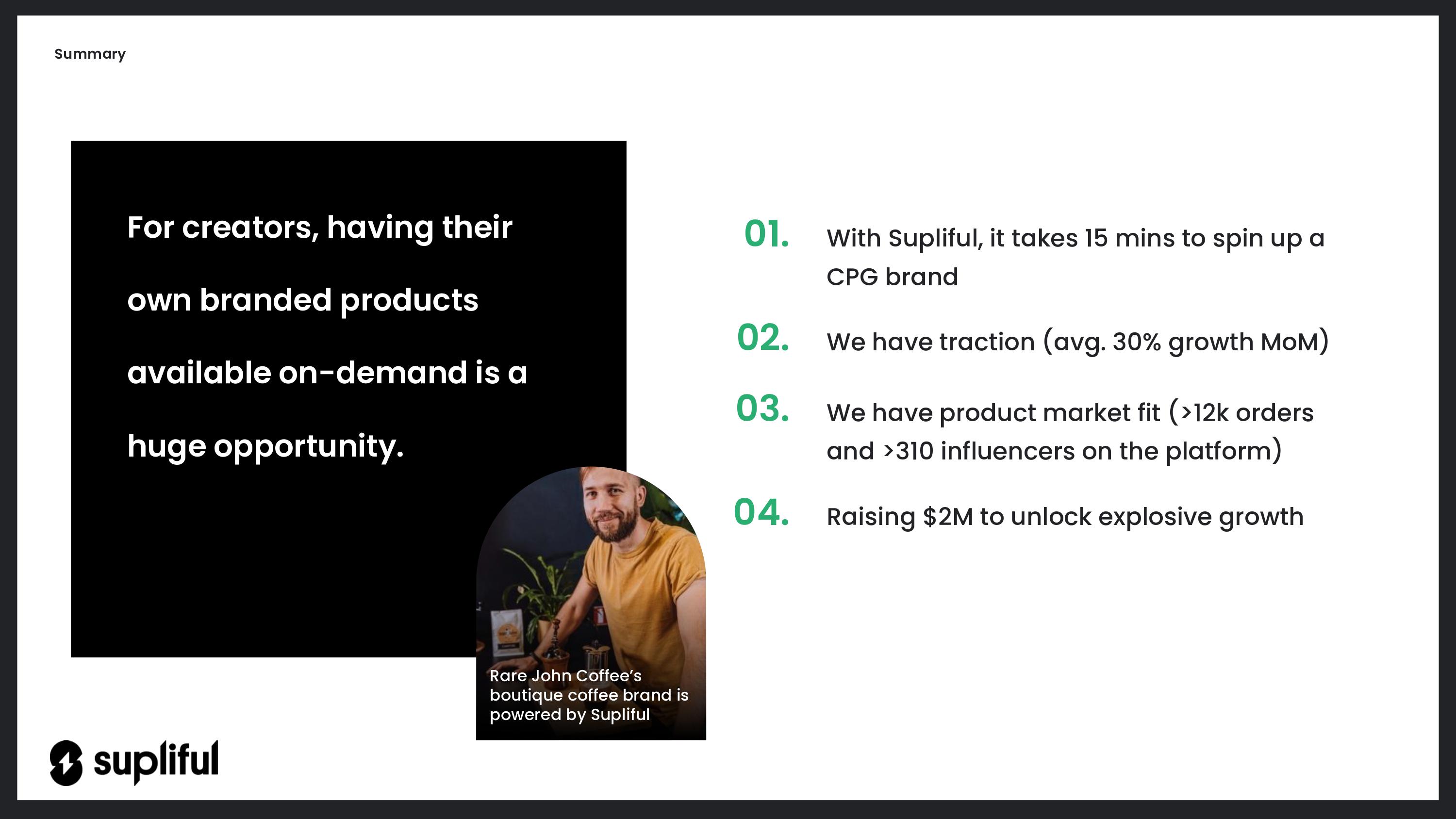
(Slide 3) Briefly … Image credits: Supliful / TechCrunch / Trulytell
I like to start with a brief slide show early on in the deck to set the pace. Here, we close the introductory three-segment bracket. It summarizes the creator’s value proposition (“It takes 15 minutes”), reminds investors that this company has real traction (average growth of 30% per month), highlights early indicators of product-to-market fit, and sums up the product and market space by saying: “Having branded products is a huge opportunity.”
What works for this chip: Honestly, I would probably exclude this slide from the pre-submission group and copy and paste the task and four bullet points into an email to get a potential investor to open the group. But I like to brag, plain and simple, why someone might want to keep reading and invest a million dollars.
What could be improved: There is a typo on the slide! The cover slide and financials show the company raising $1 million, but that amount says $2 million.
As we worked through the operating plan (second to last slide), we decided the financials looked good enough that we just needed to raise a million dollars and we turned it around, but we forgot to turn it around here. Was it easy to go back and fix that and re-export the chip? Yes, but I want to point out that mistakes happen, even when you have a lot of smart people trying to create a “perfect” presentation.
Slide 4: Problem slide
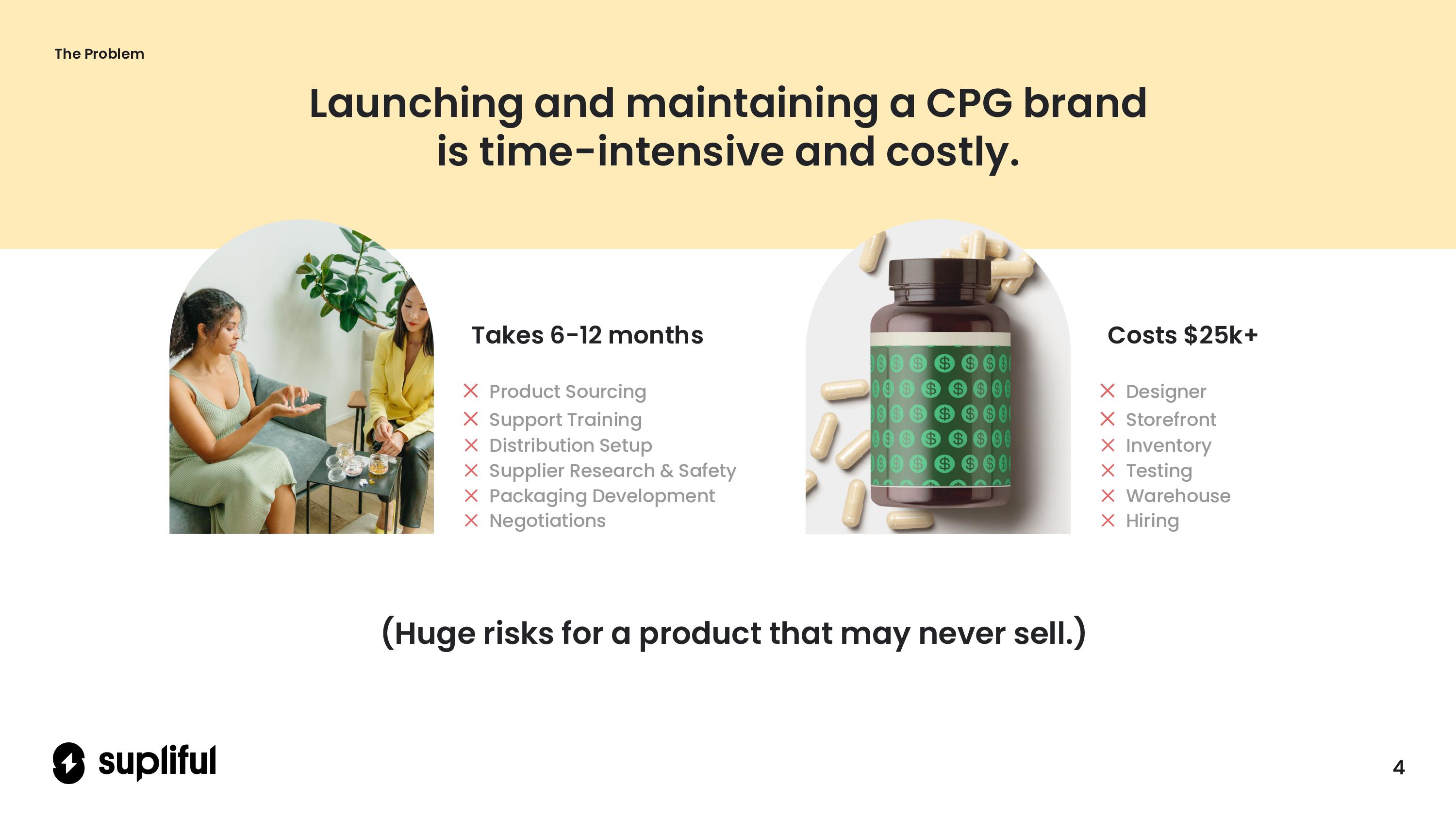
(Slide 4) So what’s the problem? Image credits: Supliful / TechCrunch / Trulytell
Every company needs a problem statement. Here, Supliful shows that this market does exist but isn’t available to lower and mid-tier content creators and influencers.
It is possible to create a consumer packaged goods brand—you can white label or craft your own—but bringing a new product to market, then branding, manufacturing, and handling shipping logistics can be an expensive and time-consuming nightmare.
That’s the problem Supliful takes on, and the fear it mitigates is beautifully illustrated at the bottom of the slide: What if I spent $25,000 and a year of my life creating something that wasn’t worth all that time?
What works for this chip: Selling by relieving fear works really well. I like that the problem statement is brief (“time consuming and expensive”) and gives us specific reasons why the process is difficult. Simple, clean and easy to understand.
What could be improved: A lot of investors have been bitten by companies trying to market to “influencers.” It is a very amorphous demographic that is relatively difficult to market. My concern here is whether an investor, upon reading this slide, might go, “So what?”
Another, more important issue I have is the potential environmental impact angle: “Do we really need more brands selling the stuff?” But I suppose if this is at the forefront of an investor’s mind, no amount of promotion will cause him to change his mind.
Slide 5: What makes a great CPG brand
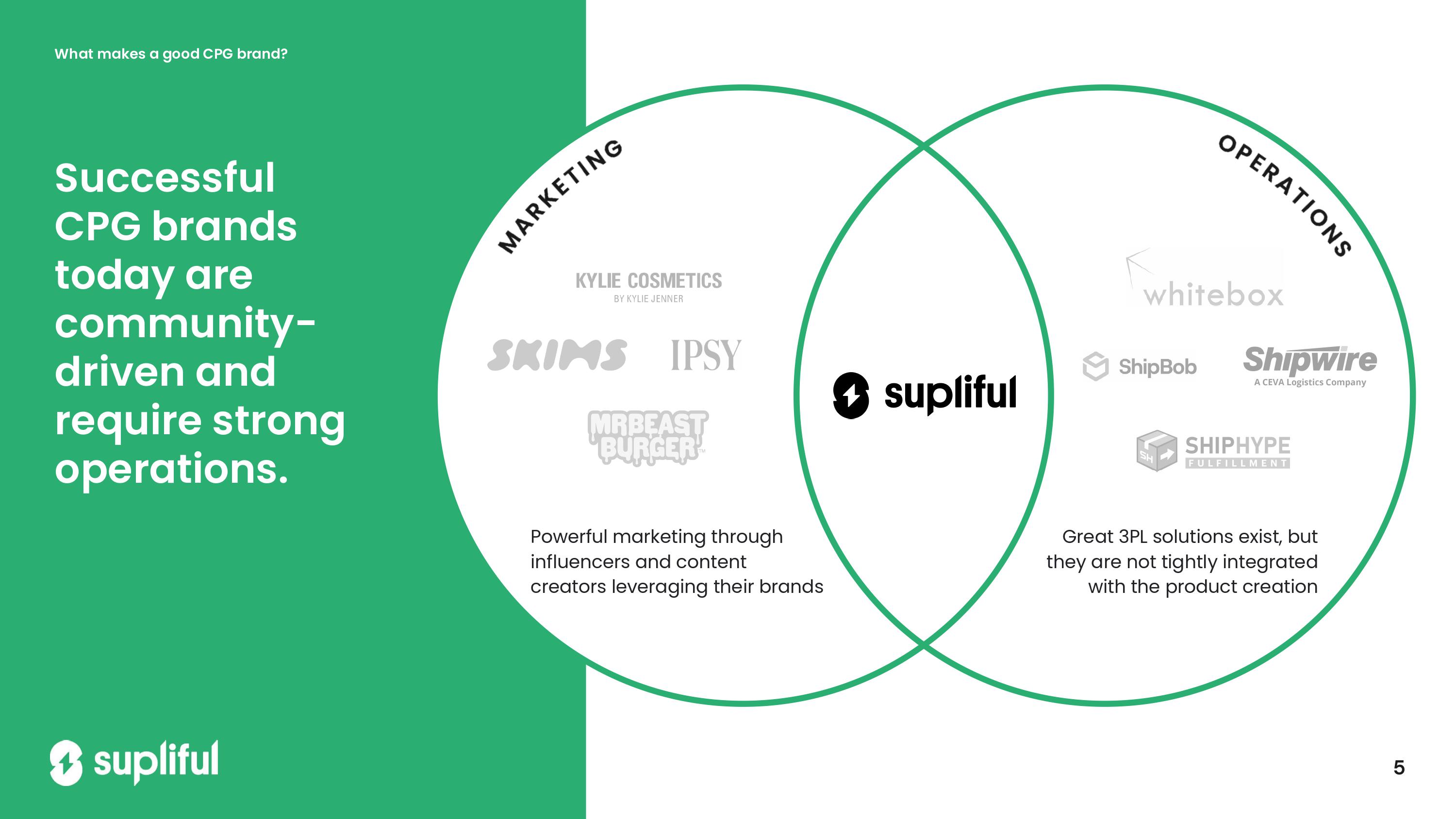
(Slide 5) So, what? Image credits: Supliful / TechCrunch / Trulytell
This slide is a bit of a curve ball because you rarely have to explain what the market is in order to explain your company.
However, the point here is that Supliful solves a really specific problem at the intersection of two industries: taking care of product, brand, and manufacturing is one industry, and taking care of billing, logistics, and the rest of the process stack is another. The companies on the left are well-known and successful brands in the previous industry, and the companies on the right are successful logistics companies.
It’s an unusual slide for a presentation platform, but I like it for this “presentation perfect” because it clearly shows that you’re not limited to the 15-16 slides that are usually recommended. If you need a slide or two to tell part of the story specific to your company, industry or market, go for it. Just make sure you have a solid understanding of why you’re including it.
In my presentation coaching practice, I often ask my clients, “What are you trying to convey here?” and “Is there a way to tell this story in one of the ‘standard’ slides?” If you have a clear answer to the first question and answer the second with a resounding “no,” you’ll probably have to get a little creative with a less standard chip.
One caveat, though: If you find yourself owning four or five non-standard slides, chances are there’s something wrong with the overall narrative or you’re deep in the weeds.
What works for this chip: This slide plants the seeds for some really huge opportunities. The 3PL (Third Party Logistics) brands on the right are very successful companies and based on the huge following, the brands on the left are interesting market competitors to watch. Supliful is trying to say that it is the “right” company to unlock these business models.
What could be improved: I suspect this story could be told without this slide, but I wanted to keep it so I can use it as an example.
For the rest of this article, we’ll take our x-ray machine to file the next 15 slides from this set.
